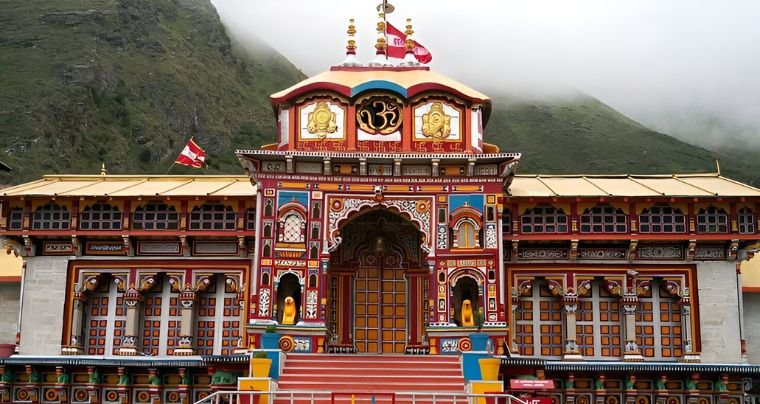Shree Badrinath Temple
The Badrinath Temple is one of the holiest sanctuaries in Hinduism, and it is situated in Badrinath (Chamoli district, Uttarakhand). It is an important location in the Char Dham pilgrimage and is devoted to Lord Vishnu, who is worshipped here as Badrinarayan.
Thank you for reading this post, don't forget to subscribe!Badrinath is one of the most revered avatars of Lord Vishnu, who is said to be in charge of preserving the cosmos in Hindu mythology. Adi Shankaracharya founded the shrine, which still inspires devotion in the breathtaking Himalayan surroundings.
Location: Uttarakhand’s Chamoli district’s Badrinath
God: Lord Vishnu
Created by: Adi Shankaracharya
Badrinath Yatra 2025: Opening and Closing Dates
The Badrinath Temple will formally open on May 2, 2025, while the Badrinath Yatra 2025 is slated to start on April 30, 2025. A significant component of the Char Dham Yatra, which also includes Kedarnath, Gangotri, and Yamunotri, is this holy journey. Until November 17, 2025, devotees can come to the temple and ask for Lord Vishnu’s heavenly blessings.
Badrinath:
Very popularly known as one of the ‘Chaar Dhaam’, (4 pilgrimages), or ‘Chhota Char Dhaam’ (chhota, meaning small) Badrinath, is one of the most important religious places for the Hindus across the world. Char Dhaam in the Hindi language means Four Dhaams (Four religious places) and is a collective term to indicate the religious circuit within Uttarakhand, which covers the four important and holy Hindu pilgrimage centres, namely Badrinath, Kedarnath, Gangotri, and Yamunotri. It is among the most visited pilgrimage sites of India, where millions of people visit every year to pay their respect to Lord Vishnu.
One of the very interesting facts about Badrinath is that though the temple is located in North India, the temple’s head priest (called the Rawal) is a Nambudiri Brahmin, who traditionally comes from the South Indian state of Kerala. It is believed that Adi Shankara, who was a South Indian philosopher, started this tradition. The priest has to practice bachelorhood.
The temple remains open only for 6 months, during summer. As soon as the winters approach, the doors of the temples are closed. On this occasion, the temple is decorated with flowers, and special pujas are performed on the day by the chief priest. A huge ghee lamp, called ‘Akhand Jyoti’ (never-ending light) is lit inside the temple, which lasts for 6 months. The idol is shifted to the Narsingh temple at Joshi Math, where the deity is worshipped for the next 6 months. Around April or May, the idol is shifted back to Badrinath, when the temple re-opens. Thousands of people visit the temple to have a darshan of the Akhand Jyoti.
Location of the temple:
One of the most famous places of worshipping Lord Vishnu, Badrinath is also called ‘Badrikanath’, or ‘Badrikaaashram’. It is one of the 108 ‘Divya Desams’ dedicated to Lord Vishnu, where he is worshipped as Badrinath. This holy shrine for Vaishnavites is located in the Chamoli district, along the river Alaknanda, in the state of Uttarakhand.
The main attraction of the city is the Badrinath temple, which is located at an average height of about 3,100 meters above sea level. This sacred town of Badrinath is located between the ‘Nar’ and ‘Narayana’ mountain ranges in Garhwal hill.
Significance of Badrinath temple:
Badrinath is considered to be the most sacred religious place for Hindus, to get rid of their sins and pave the path to the ultimate goal of human life – the Moksha, (salvation and freedom from the cycle of birth & death in this world). Badrinath is one of the holy places where the Hindus offer ‘tarpan’ (oblations to ancestors). Devotees have a holy dip in the Alaknanda River and then go for darshan. It is believed that a dip in the holy river purifies the soul.
Badrinath temple is among the ‘Chaar Dhaams’ located across the four corners of India. While Badrinath is in the North, the other three are Jagannath Temple at Puri, Odisha (East), Dwarakadheesh Temple at Dwarka, Gujarat (West), and Rameshwaram Temple at Rameshwaram, Tamil Nadu (South). Chaar Dhaam Yatra is one of the very important rituals. Every Hindu is expected to perform this yatra at least once in the lifetime. Traditionally, the yatra starts at the eastern end from Puri and then proceeds in a clockwise manner (as typically followed for circumambulation in Hindu temples). So, the yatra starts from Puri, and then moves to Rameshwaram, Dwarka, and finally at Badrinath.
In addition to the main ‘chaar dhaams’ mentioned above, there are four abodes called the ‘Chhota Chaar Dhaam’ (Chhota meaning small). All these abodes, namely Badrinath, Kedarnath, Gangotri, and Yamunotri lie in the foothills of the Himalayas. The name Chhota was added in the last century to differentiate these dhaams from the original Char Dhaams. Now, these are also called ‘Himalayan Chaar Dhaams’.
Legends of Badrinath Temple
Rich in mythology, the Badrinath Temple is encircled by intriguing legends:
King Sagar, a powerful Suryavanshi monarch, endured a curse that prevented his 60,000 sons from being saved long before Lord Rama was born. This is the story of the Ganga’s descent. To free their spirits, King Bhagirath, his descendant, appealed to Lord Brahma, who commanded the Ganga River to descend to Earth. The Ganga’s strong flow, however, was uncontrollable. After that, Bhagirath turned to Lord Shiva for assistance, who gently freed Ganga after trapping her in his matted hair. Sagar’s boys were saved when a stream of Ganga, called Alaknanda, poured over their ashes. For the area, this day, known as Ganga Dussehra, has spiritual importance.
Another tale states that Lord Vishnu pondered in the peaceful location of the Badri Tree, oblivious to the bitter cold. His consort, Maan Lakshmi, changed into an Indian jujube tree, or Badri tree, to protect him. Lord Vishnu was pleased by her devotion and gave the location the name Badrika Ashram. He is therefore revered as Badrinath, Badri’s husband, and Maan Lakshmi as Badri Vishal.
History of the Temple
Adi Shankaracharya lived here for six years in the eighth century and founded the Badrinath Temple, which is devoted to Lord Vishnu. He first placed a black stone statue of Lord Badrinarayan in a cave close to the Tapt Kund (hot springs) after finding it in the Alaknanda River. The idol was constructed of Saaligram stone. The idol was relocated to its current site by the King of Garhwal in the sixteenth century.
Because of its antiquity and natural disasters, the temple has undergone several repairs over the years. The temple was enlarged by the Garhwal King in the 17th century, and the King of Jaipur led the effort to restore it following severe damage from the Himalayan earthquake in 1803.
Architecture of Badrinath Temple
The Sabha Mandap (assembly hall), Darshan Mandap (prayer hall), and Garbha Griha (sanctum) are the three portions of the Badrinath Temple, a masterpiece of North Indian temple architecture. The façade has elaborate masonry and arched windows, while the sanctum’s conical roof, which rises 15 meters high, is topped with a cupola plated in gold.
A one-foot black stone statue of Lord Badrinarayan in Padmasana, clutching a Shankh and Sudarshan Chakra, is housed in the main shrine. A heavenly and architectural wonder, it is surrounded by idols like as Kubera, Narad, Nar-Narayan, Maan Lakshmi, and Garuda, as well as saints Adi Shankaracharya and Ramanujacharya.
Important Festivals and Poojas
-
The most important festival held at Badrinath temple is called ‘Mata Murti Ka Mela’. The festival commemorates the descent of the River Ganges from heaven. It is believed that the mother of Badrinath divided the river into 12 channels for the welfare of the Earth. The places where Ganga flowed became the Holy Badrinath Temple. So, she is worshipped on this day.
-
Badri Kedar festival: This festival is celebrated both Badrinath and Kedarnath around the month of June. The festival lasts for eight days where artists from around the world gather and recite Vedic scriptures such as Ashtotram and Vishnu Sahasranama during the rituals.
The major pujas performed at Badrinath temple
In the morning there is Mahabhishek (ablution), Abhishek, Gita Paath, and Bhagavat Puja, while in the evening the pujas include Geet Govinda and aarti. After the daily aarti, the decorations are removed from the deity’s idol and sandalwood paste is applied to it. This paste is given to the devotees the next day as ‘prasad’ during the nirmalaya darshan. Unlike most other temples, in Badrinath, all these rituals are performed in front of the devotees. Prasad is also distributed to all the devotees.
Best time to visit Badrinath temple:
The temple is open for only 6 months in a year –i.e. in summers. The temple is closed around the time of Diwali (October/November) and re-opens after 6 months around April or May. So, the best time to visit Badrinath is from May to October, where you can enjoy the scenic beauty and the weather is also pleasant.
How to reach Badrinath?
-
By Air: The nearest airport to Badrinath is Jolly Grant Airport at Dehradun, which is at a distance of 314 km. From here one can easily get a taxi to reach Badrinath. Dehradun airport is well connected to Delhi and has daily flights from Delhi.
-
By Train: The nearest railway station is Rishikesh, which is 295 km away from Badrinath. There are regular trains to Rishikesh. Regular taxi and bus services are available from Rishikesh to Badrinath.
-
By Road: Buses and taxis are easily available to Badrinath from major destinations of Uttarakhand. The nearest cities are Haridwar (24 km), Rishikesh (71 km), Deoprayag (30 km), Rudraprayag – (20 km), Karnaprayag – (20 km), Nandprayag – (11 km), Chamoli – (8 km), Joshimath – (13 km), and Vishnuprayag – (8 km)
You can also visit Uttaranchal govt website for more information relating to tourism.




